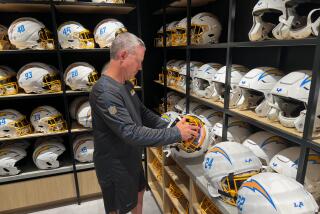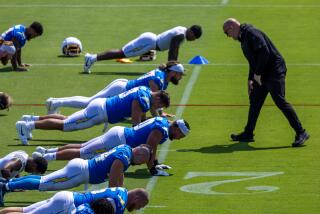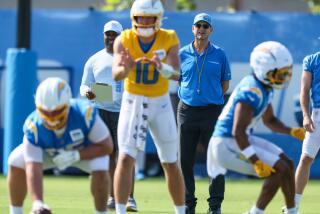Southern Discomfort
- Share via
THIBODAUX, La. — A 13-foot alligator is on the loose. That should come as no surprise to the New Orleans Saints, who have spent the last two summers living with the realities of the NFL’s most otherworldly training camp.
This is the heart of the bayou, after all, where beetles the size of cigarette lighters--locals call them, “flying cockroaches”--buzz around, and there is a $4 bounty on swamp-dwelling nutria rats, which are as big as terriers and have burnt-orange teeth. The air is impossibly steamy, especially after it rains, which happens roughly once a day.
Some teams spend their summers in comfy locales--the Raiders in Napa, the Cowboys in the air-conditioned Alamodome, the Buccaneers at Disney World. The Saints have chosen Nicholls State University here in Thibodaux, about an hour’s drive southwest of New Orleans.
“It’s the worst camp in the league,” said tackle Kyle Turley, voicing a common sentiment among Saint players.
The worst?
Not for alligator hunters. Lake Bouef is boiling with gators, and they’re easy to spot. Just go there at night and scan the surface with a flashlight. Their eyes glow a brilliant red. It’s a favorite hangout for Capt. Danny Kraemer, a Nicholls State campus policeman.
“When you shine a light, that lake looks like a Christmas tree,” said Kraemer, when runs a zoological supply business on the side and, at the moment, is on the trail of a 13-foot beauty.
A year ago, Kraemer caught a smaller gator in a ditch just off campus, bound it with duct tape and hoisted it into the bed of his pickup truck. He then drove it to camp so players could get a glimpse. Coach Jim Haslett nearly jumped out of his skin when someone grabbed the back of his leg as he was leaning into the truck to take a peek. He wasn’t the only one spooked.
“It was scary, man,” defensive tackle Norman Hand said. “I was coming up to meetings and the next thing I know I see this eight-foot gator. I’m wondering who the hell brought it on campus. [Kraemer] wanted me to wrestle it, man. I’m a brave man, but I ain’t that brave.”
Receiver Joe Horn is less concerned about the heat, rats and gators than he is about mosquitoes that could carry the West Nile virus. Each morning, around 5:30, a plane makes a few passes over the practice field, spraying the area with pesticide. Mosquitoes have not been a problem so far, but horn doesn’t want to take any chances.
“It’s like a state of emergency and we’re still out here practicing,” he said. “It’s bad. I think more should be done about it. You know when those tornadoes come through and tear up a neighborhood, they call it a state of emergency and [President] Bush comes in and helps them and all that? That’s what should happen here.”
Hand isn’t quite ready to declare Saint camp a disaster area, but he has seen how the other half trains. He spent three seasons with the Chargers, spending his summers in relative paradise.
“This ain’t La Jolla,” he said. “I felt like passing out, the first practice here. The humidity was brutal--it’s still brutal--but the thing is, it’s getting us ready for the opening game against Tampa Bay. I think the team that’s in the best shape will win that football game. I’ll definitely take these conditions.”
The old-time Saints used to practice in Thibodaux, back when the bug zappers crackled so loudly that Archie Manning actually had problems calling audibles. The team later moved its training camp to Crosse, Wis., where it spent 11 summers before moving back to Thibodaux in 2000. Holding camp in the bayou reportedly pumps $2.6 million a year into the local economy.
According to documents obtained last year by The Times, the Saints lost $849,000 in 1999, making them the only NFL team to finish the year in the red. They have since signed a 10-year, $186.5-million guaranteed revenue deal with the state that is said to ensure them more than the league average in revenue. The move back to Thibodaux was, in part, a good-will gesture by Saint owner Tom Benson, whose team is in the final year of its deal with Nicholls State.
At the urging of Haslett, the franchise has made the camp more livable by paving the gravel path from the practice fields to the locker room, and freshening up the facilities with new paint and carpeting. The laundry rooms were upgraded too, meaning assistant trainers no longer stumble around like zombies because they have been up all night, cleaning uniforms.
Still, there is a good chance the Saints will leave Thibodaux after this summer and move training camp to team headquarters in a New Orleans suburb, where the team is building an indoor practice facility scheduled for completion by January. Haslett’s biggest gripe about Thibodaux is that the team has nowhere to practice when it rains. The only alternative now is to pile into a bus and drive to the Superdome, where there are occasional scheduling conflicts.
Team officials last summer even investigated practicing in a sugar-cane warehouse in Thibodaux. But the place was too small, the floor was uneven and the ceiling was too low to throw passes, let alone punt. Regardless of the conditions, the Saints still draw fans by the thousands. Nearly 10,000 people filled the stands earlier this month, paying $12 a seat to watch the Black and Gold scrimmage, which was basically a showcase for second- and third-string players. More than an hour afterward, the stands were still loaded with people because the players and coaches stayed around to sign autographs. Turley, a local hero so popular he served as grand marshal of a Mardi Gras parade, tossed T-shirts to the crowd and signed autographs until his hand ached.
The support of Saint fans, Turley says, is the only thing that makes training camp tolerable. That and the gumbo from Bubba’s II, a restaurant-sports bar in town also famous for its boiled crawfish soup and bacon-wrapped shrimp. The guy who owns the place, Doug Swanner, is such a fan, he has been known to drive to road games--even as far as Denver--with a truckload of jambalaya fixings. When he gets there, he cooks for the players and coaches.
Asked how it would affect Thibodaux if the Saints left, Swanner said, “I don’t think it would be devastating. It would hurt. But this is a strong community.”
Strong enough, in fact, to survive the population explosion of nutria rats, which feast on swamp grass and are causing the ground to erode at an alarming rate. Typically, the folks in Thibodaux look on the bright side.
Locals say those rats taste even better than chicken.
More to Read
Go beyond the scoreboard
Get the latest on L.A.'s teams in the daily Sports Report newsletter.
You may occasionally receive promotional content from the Los Angeles Times.











